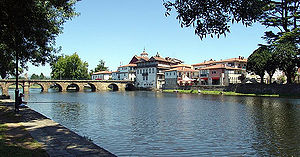Royalist attack on Chaves
| Royalist attack on Chaves | |||||||
|---|---|---|---|---|---|---|---|
 The city of Chaves |
|||||||
|
|||||||
| Belligerents | |||||||
|
|
|
||||||
| Commanders and leaders | |||||||
| Augusto Ribeiro de Carvalho | Henrique Paiva Couceiro | ||||||
| Strength | |||||||
| 100 regular soldiers 160 civilian volunteers Several artillery pieces |
450 rebels 2 artillery pieces |
||||||
| Casualties and losses | |||||||
| light casualties | 30 dead | ||||||
![]() Royalist supporters Supported by:
Royalist supporters Supported by:
The attack on Chaves, which occurred on July 8, 1912, was a military action performed by supporters of the monarchy of Portugal in opposition to the Portuguese First Republic, which had been proclaimed two years prior.
The attack was led by Henrique Paiva Couceiro, who had campaigned in Africa and who had become the leader of the royalists. The royalists had been discreetly armed by the Spanish king, Alfonso XIII, and had concentrated their forces in Galicia.
The attack ended with a defeat for the royalist forces.
Couceiro had undertaken a first incursion in 1911 with about 1,000 men, who had formed in groups of 60-70 men. They had left the town of Verín, 12 kilometers from the northern border with Spain, and had marched towards the border. Most of the men were from the region of Trás-os-Montes and were from a diverse array of social classes and skills. There were more than 100 priests in the group. In terms of military equipment, there were only 400 ancient rifles, a few Winchester rifles, and Mauser Pocket Pistols adapted to rifles, to which were added a score of semi-automatic pistols, daggers, and swords. The 1,000 men had crossed the border after a long march in the mountainous region between Bragança and Vinhais, near the present-day Montesinhos National Park.
...
Wikipedia
